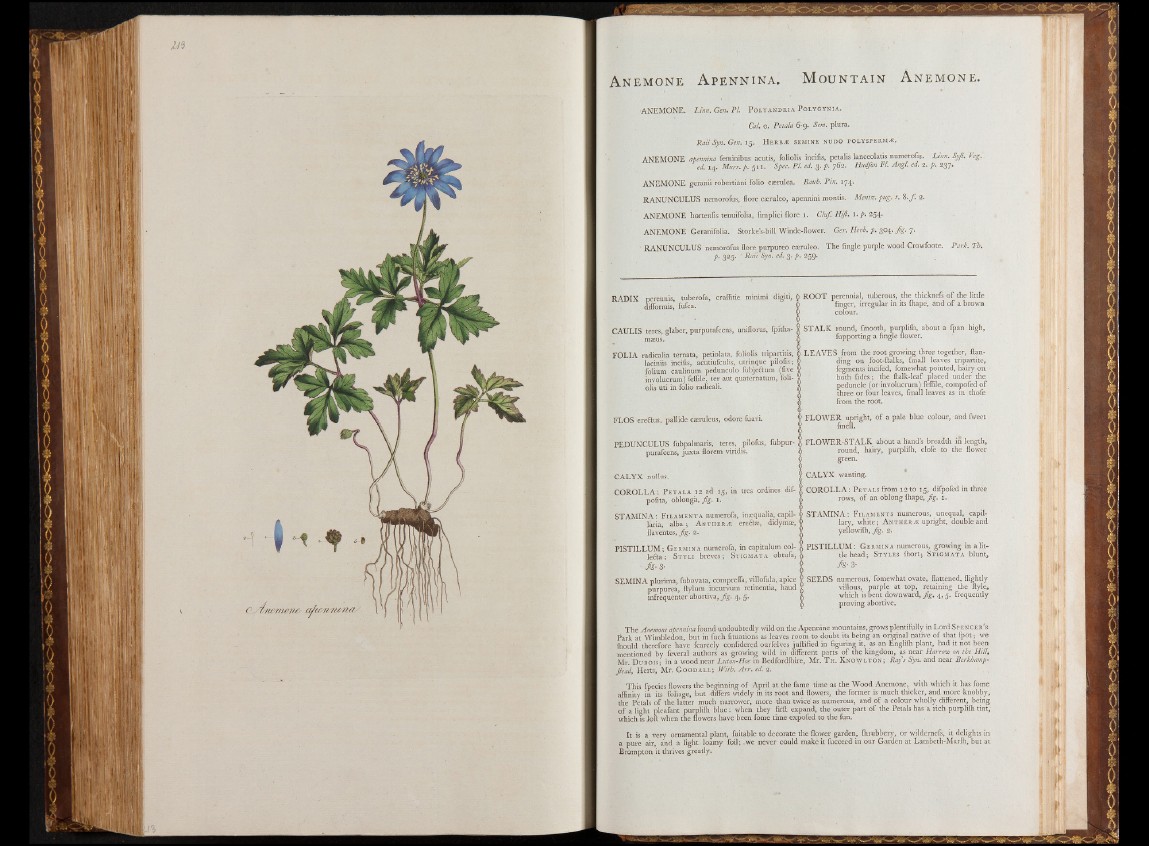
C L S Z T iem on e'
ANEMONE. Linn. Gen. PI. Polyandria Polygyn ia.
Cal. 0. Petala 6-g. Sem. plura.
RaiiSyn. Gen. 15. Herbæ semine ndoo polyspermæ.
ANEMONE apennina feminibus acutis, foliolis incilis, petalis lanceolatis numerofis. Linn. Syfi. Veg.
ed. 14. Mint, p. 511. Spec. P l ed. 3. p. 762. Hudfion FI. Angl.pd. 2. p. 237.
ANEMONE geranii robertiani folio cærulea. Baub. Pin. 174.
RANUNCULUS nemorofus, flore cæruleo, apennini montis. Mentz. pug. t. 8. f . 2.
ANEMONE hartenfis tenuifolia, fimplici flore 1. Cluf. Hiß. 1 • p. 254-
ANEMONE Geranifolia. Storke’s-bill Winde-flower. Ger. Herb. p. 304. fig . 7.
' RANUNCULUS nemorofus florè purpureo cæruleo. The Angle purple wood Crowfoote. Park. Fb.
p. 325. • Rdii Syn. ed,:%. p . 25g.
RADIX perennis, tuberofa, craffitie minimi digiti, $
mfformis, fufca. §
CAULIS teres, glaber, purpurafcens, uniflorus, fpitha- I
ROOT perennial, tuberous, tbe thicknefs of the little
. maeils. ©
FOLIA radicalia temata, petiolata, foliolis tripartitis, h
laciniis incifis, acutiufculis, utrinque pilofis; ©
folium caulinum pedunculo fubje&um (five ©
involucrum) feffile, ter aut quatematum, foli- *
olis uti in folio radicali. K
FLOS ere&us, pallide casruleus, odore fuavi.
PEDUNCULUS fubpalmaris, teres, pilofus, fubpur- |
purafcens, juxta florem viridis. |
C A L YX nullus. . ' . f
COROLLA: Petala 12 ad 15, in tres ordines dif- |
pofita, oblonga, Jig. 1. ©
STAMINA: Filamenta numerofa, inzequalia, capil- |
laria, alba; A nth-er^e ereftae, didymas, V
flaventes, Jig. 2. , a
PISTILLUM; G ermina numerofa, in capitulum col- |
lefta; St y li breves; Stigmata obtufa, |
' fg- 3* ‘ ' • I
SEMINA plurima, fubovata, comprelfa, villofula, apice V
purpurea, ftylum iricurvum retinentia, haud a
mfrequenter abortiva, Jig. 4, 5. , |
finger, irregular in its fhape, and of a brown
colour.
STA LK round, frfiooth, purplifh, about a fpan high,
fupporting a fingle flower.
LEAVES from the root growing three together, Handing
on foot-ftalks, fmall leaves tripartite,
fegments incifed, fomewhat pointed, hairy on ■
both fides; the ftalk-leaf placed under the
peduncle (or involucrum) feflile, compofed o f
three or four leaves, fmall leaves as m thofe
from the root.
FLOWER upright, of a pale blue colour, and fweet
fmefl.
FLOWER-STALK about a hand’s breadth in length,
round, hairy, purplifh, clofe to the flower
green.
CA L YX wanting.
COROLLA: Petals from 12 to 15, difpofed in three
rows, of an oblong fhape, fig . 1.
STAMINA: Filaments numerous, unequal, capillary,
white; A ntheRiE upright, double and
yellowifh, Jig. 2;
PISTILLUM: G ermina numerous, growing in a little
head; Styles fhort; Stigmata blunt,
fig- 3-
SEEDS numerous, fomewhat ovate, flattened, flightly
villous, purple at top, retaining the ftyle,
which is bent downward, Jig. 4,5. frequently
proving abortive.
• The Anemone apennina found undoubtedly wild on the Apennine mountains, grows plentifully in Lord Spencer’s
Park at Wimbledon, but in fuch fituations as leaves room to doubt its being an original native of that fpot; we
fhould therefore have fcarcely confidered ourfelves juftified in figuring it, as an Englifh plant, had it not been
mentioned by feveral authors as growing wild in different parts of the kingdom, as near Harrow on the H ill,
Mr. Dubois; in a wood near Luton-Hoe in Bedfordfhire, Mr. T h. K nowlton; Rays Syn. and near Berkhamp-
Jlead, Herts, Mr. G oodall; With. Arr. ed. 2.
This fpecies flowers the beginning of April at the fame time as the Wood Anemone, with which it has fome
affinity in its foliage, but differs widely in its root and flowers, the former is much thicker, and more knobby,
the Petals of the latter much narrower, more than twice as numerous, and of a colour wholly different, being
of a light pleafant purpliffi blue: when they fifff expand, the outer part of the Petals has a rich purplifh tint,
which is loft when the flowers have been fome time expofed to the fun.
It is a very ornamental plant, fuitable to decorate the flower garden, fhrubbery,, or wildernefs, it delights in
a pure air, and a light loamy foil; -we never could make it fucceed in our Garden at Lambeth-Marfh, but at
Brompton, it thrives greatly.